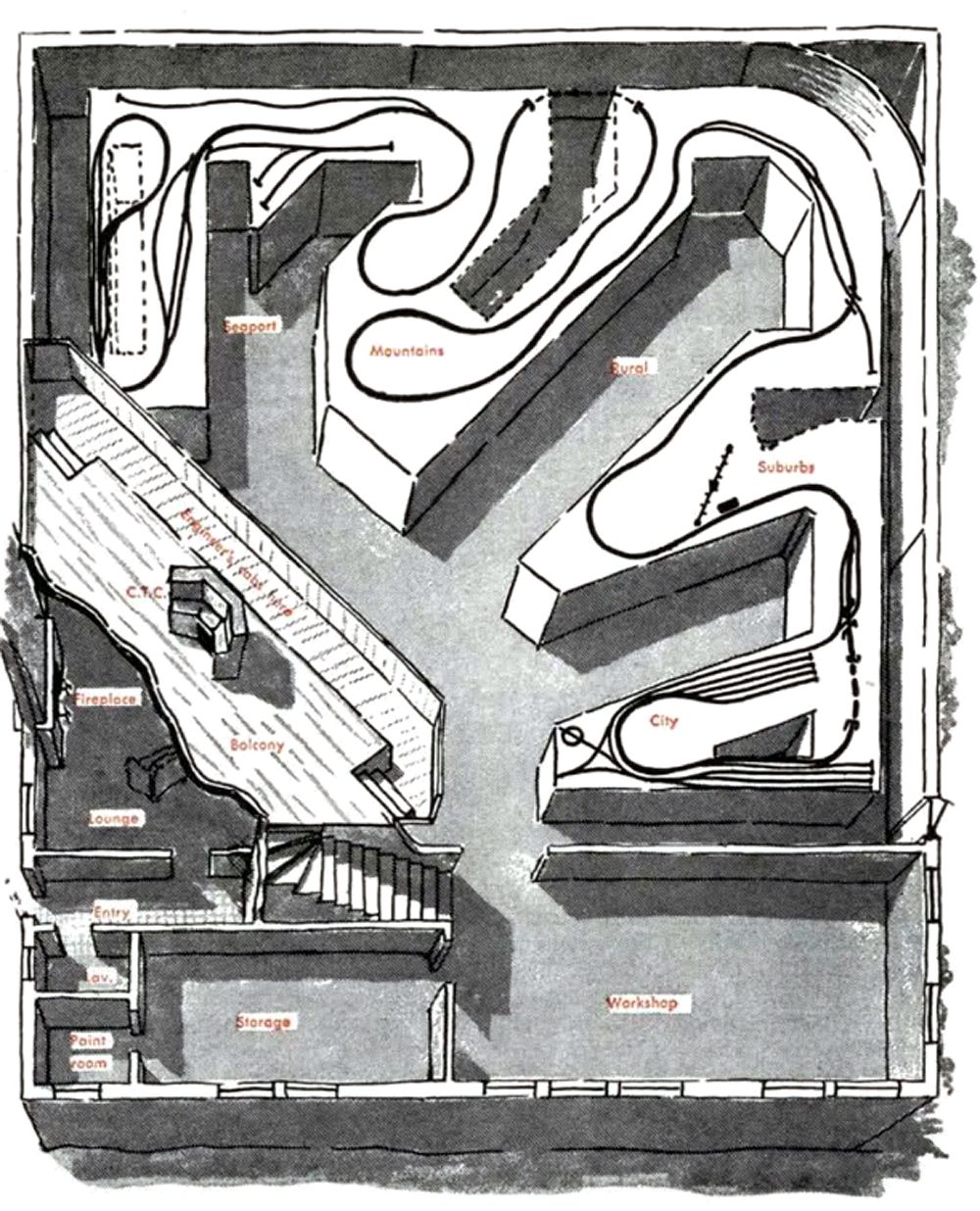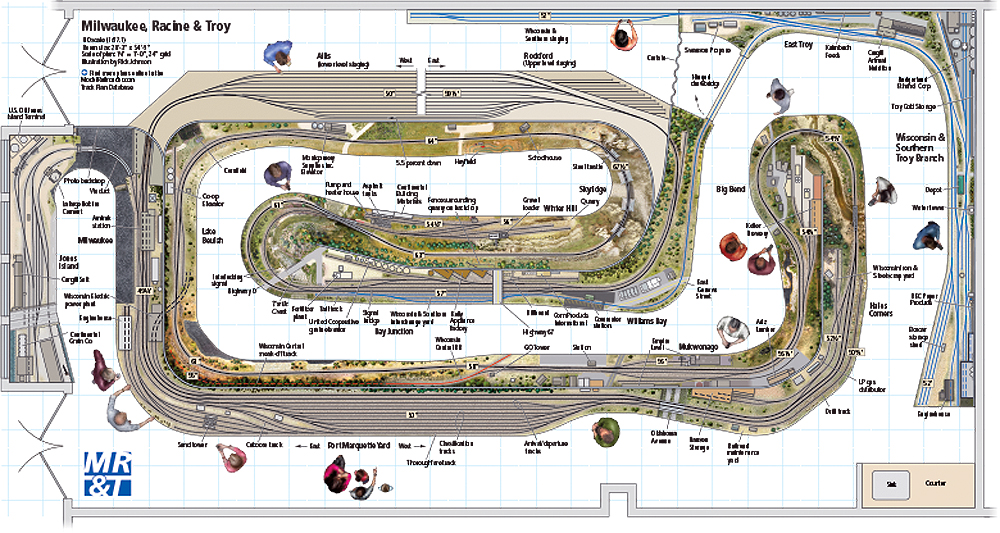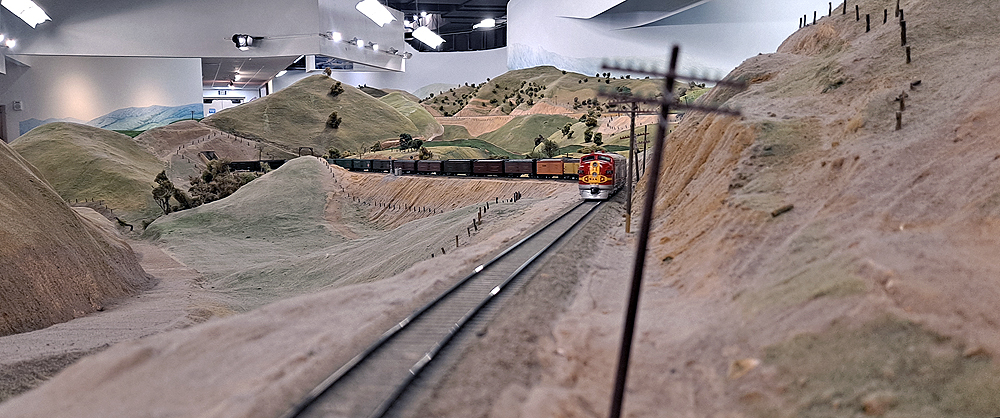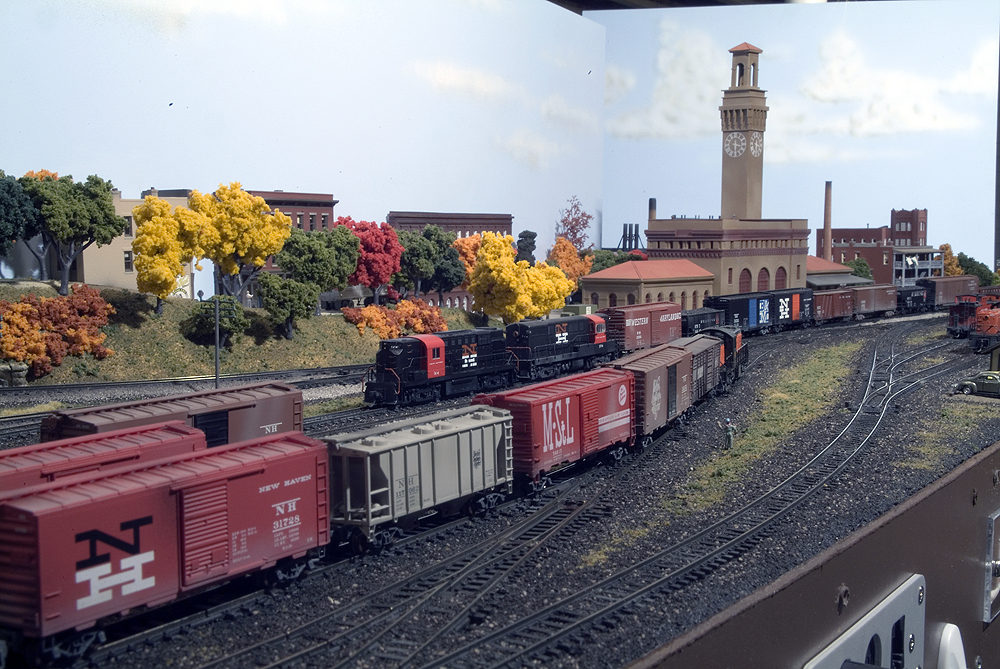In 1951, Linn Westcott wrote a story about his ideas for a million-dollar model railroad. It was a thought experiment that looked at everything from the layout space to how he’d control the trains. You can read about it here.
A recently republished interview with Linn on Trains.com got some of us thinking about what we would do today with what Linn thought of as a practically unlimited budget to build a million-dollar model railroad.
Now, $1 million in 1951 could certainly buy more than it could now. I checked the website, which told me you’d need almost $12 million today to buy what you could in 1951, but what’s a couple million between friends? The idea behind Linn’s article was, if money were no object, what kind of layout could you build?
Steven Otte and I admitted to eyeing vacant supermarket buildings as ideal homes for a mega-layout. A quick search of real estate offerings showed that even an empty supermarket isn’t cheap. However, a modern “pole barn” type of building could be had for quite a bit less, and you wouldn’t have to share space with any questionable neighbors. The building could either be a square or long rectangle.

A place for trains
From Linn’s article, where he shared his ideas for a million-dollar model railroad, it seems he was taking into consideration the structure that would contain the mega layout. He mentions lighting effects, space for two workshops (woodworking and model making), and a lounge area for guests.
A pole barn on a concrete slab would require some sort of resilient flooring for comfort, and in most climates, would also need insulation, heating, and air conditioning. If you were to include workshop space in the layout building, which would make sense, then you’d want lots of natural light for the workshop. The layout space doesn’t need exterior light, but skylights might be nice.
Most of the light would come from artificial sources, and the various types of light-emitting diode (LED) fixtures available today should solve all of our problems without adding unnecessary heat. Computer control would allow for the effects of sunrise, sunset, and even the sun passing across the sky, with motorized spotlights shining from the proper direction based on the time of day.
While Linn imagined pumps to move water around, I’ve never felt that water “scales” well. For an HO scale layout, real water flows too fast and looks too shallow to appear realistic. Sound effects would probably do a better job of simulating movement on water, along with special lighting effects.
Depending on your goals for your million-dollar layout, the building could either be a large square, or a long rectangle. If you prefer mountain railroading, the square might work better. Prairie railroading would do well in a long rectangle to depict the long tangents trains take across the Midwest and Plains states.

What about the trains?
With the building out of the way, what goes inside is the next thing. In Linn’s ideas for a million-dollar model railroad, he imagined a balcony for the engineers to sit where they could overlook the whole layout to run their trains. That was the state of the art in 1951. The current concept of control favors being able to walk alongside your trains using Digital Command Control and sound decoders.
One of the areas often compromised in the typical layout is aisle space. Having wide aisles makes it much more comfortable to walk along, especially if you have to share the space with other operators. If you had unlimited funds, you could make the aisles as wide as you liked. I’d set my minimum at 4 feet and have many areas wider.
A mountain railroad could curve through the square footprint in the spiral peninsula design favored by professional layout designers. A prairie layout could run down the center of its space, allowing industries to be placed prototypically on either side of the main line. Intersecting railroads could be accommodated by wider areas of the building, with trenches built down under the benchwork with steps at either end to eliminate duckunders. If you’re really going big, you could replace the stairs with Americans with Disabilities Act-compliant ramps or wheelchair lifts.
With all of our money, signals and Centralized Traffic Control would be a possibility. If you prefer timetable and train order operations, then the needed phone system could feature vintage handsets to give operators a more immersive experience.

Can it be too big?
But is a huge layout the best way to approach the idea of unlimited funds? I reached out to professional layout designer and builder Lance Mindheim, who shared his Bishop Street Branch project in the January, February, March and April 2023 issues of Model Railroader.
“After thinking about it, where I come to is this: if you’re mostly a one-man band (which most of us are), you quickly hit a max in terms of layout size where having all of the money in the world won’t advance your cause,” Lance said. That’s because the true limiting factor is time. If you have folks to help you, even if you pay them, there’s still going to be that time factor.
As Lance and I traded emails, it occurred to me that such a layout already exists — the La Mesa Model Railroad Club’s Tehachapi Loop layout at the San Diego Model Railroad Museum. It’s huge — 25 scale miles of track (35 if you include staging) that takes more than an hour to run from end to end. It’s in a space that’s about 100 feet long, 50 feet wide, and 25 feet high. Areas of it aren’t just double-decked, it’s built on two floors of the building. Well, actually, a mezzanine was constructed over the lowest parts of the layout.
The club averages about 140 members. They’ve been at this project since the early 1980s and it still isn’t complete. There’s that time factor.

You don’t need a million to have fun
So what do we take from all of this? Can you build a mega layout? Lance points out that huge commercial projects exist, such as Miniatur Wünderland in Hamburg, Germany, or the Northlandz layout in Flemington, N.J., but while both are great spectacles, neither is what most of us think of as model railroads. Even with a huge crew, getting a high quality layout is going to be difficult.
If you want to see the results of your investment, “The only way to make any reasonable degree of progress is to take more of a representational approach to the models,” said Lance. And while you can spend on the latest and greatest locomotives and rolling stock, there’s a limit to how much of that you’ll need, even for a fairly large layout.
But don’t despair.
“There is a very positive message in all of this. All of the money in the world won’t get you an exceptional model railroad. It can’t. Since money doesn’t drive excellence, an amazing layout is within reach of anybody with a middle class income,” said Lance.
There’s no need to wait for the lottery to pay off, or for a huge, unexpected inheritance to show up. You probably have most of what you need to build an excellent layout.
Time to get back to the basement and back to work!














I have seen on local Seattle television an incredible HO layout belonging to man described only as a “tech executive” living in very expensive area of town. The narrator emphasized that the layout owner had a fulltime staff of three people who only worked on the layout! IMO, that’s not any fun, unless you are one of the employees who gets paid to have fun, but not for the owner. Kudos go to Rod Stewart for doing his own modeling, rather than hiring out what makes model railroading fun– building stuff!
Something like this has been built and is for sale. Entertrainment Station in Cincinnati.
I would build it so you could not see any part of the layout except where you were at the current moment. Think of a design something similar to a maze.
To enhance this effect lighting would flow with you. That is, as you came into the area, it would slowly (or instantly) light up. Behind you would go dark (unless you had a meet with another train)
I might even put in some sort of moving chair so the operator wouldn’t have to walk or stand for the perhaps 1-2 to complete the full layout (I’m old).
Ambient sounds would also be at locations and not heard from other parts.
Would water and coaling stops be needed? I’m not sure but these ideas would be where I would start.
There’s a club in Hicksville NY that follows this (except for the lighting) very closely. You walk around with your train and only see part of the layout you’re running through.
I must have spend under $5,000 building my current Trewsville Southern section, but I enjoy running trains on my 12′ by 18″ setup, I love that I get to spend 30-50 minutes running T81 around Raingold to serve the industries that need to be served.
Always fun to day dream about though. And oh yeah, that eats into your Railroad time too. . . . .
Time is priceless, regardless of how much money you have. I suppose if you had the kind of money they are talking about, you would have more “time” to spend on your project (aka your Railroad), because you wouldn’t have to earn a living, there would already be an income. There is that benefit, but then the time you do spend on your railroad would get sidetracked by other things. Spouses take a LOT of time, they would want to travel, have dinner parties and take the kids on adventures which would cut into your time. No spouse, well you would need “companionship” of some sort of the personal kind, and that takes up time too, even inflatable ones. And then there are your other interests, even if it involves railroads or not. The gym, hiking, railfaning, learning Japanese and reading those novels that have piled up next to the bed will eat into your time. And although you could hire out the lawn and other home projects, that still takes management, even if you have someone else to manage it for you they still need oversight. So, money isn’t the answer, and neither is time.
What is probably most important, is dedication to the project. You can create a lot being dedicated and having focus to the vision, even without a lot of money, or time. It becomes about priorities, and balance, which will equal a happy life and an amazing railroad in the basement/pole building/garage or even the attic.
The late John Allen was often asked, “How much money have you spent building the Gorre & Daphetid?” His answer: “The equivalent of two packs of cigarettes a day”. I have used the same answer to the same question, adding, “who do you think spent his money more wisely?” Allen’s great railroad is largely due to a man who was frugal so that he could spend 8 hours a day on his hobby. He also never mowed his lawn or trimmed the bushes because he was in his basement so much. Money aside, he spent his time, and his life, building one of the greatest model railroads ever, and Allen died young.